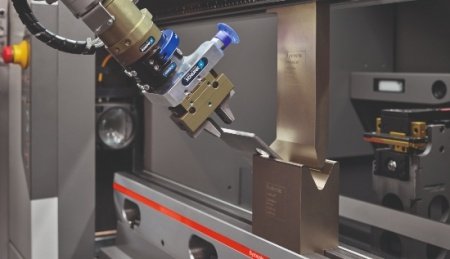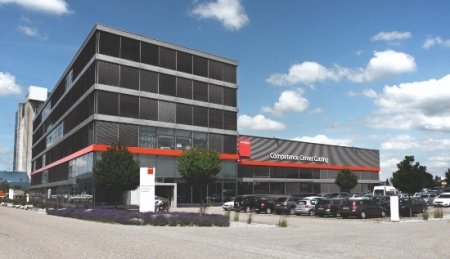168 Motion Plastics Innovations From The Home Office
In a difficult environment, more innovations than last year – from the integrated robot drive up to the ball bearing with 21 times the service life
igus increases the pace of innovation despite the pandemic: high investments in digitalisation, logistics and remote consulting increased online sales by 30 per cent in 2020 and mitigated the decline in sales by 4.8 per cent. The motion plastics specialist is also breaking new ground in terms of sustainability and product innovation, and will be presenting more innovations than ever before with 168 tribo-polymer products in spring 2021.
Last year, the turnover of the motion plastics specialist igus fell by 4.8 per cent to 727 million euros in the wake of the Corona crisis. The company is optimistic for the current year, thanks to a significant increase in incoming orders. In addition, the pandemic period has led to a surge in innovation when working from home. The result is 168 new products, product extensions and digital offers this spring, more than ever before. igus will be giving a first preview at the Hannover Messe Digital Edition. The company will also be presenting all its spring news at its own physical-virtual trade show. It has just been awarded the “iF Design Award” and will be completely renewed for visitors from 5th May.
ReBeL accelerates cost-effective automation
After two years of development, the ReBeL, a new robot drive element, can be seen at the igus exhibition. Customers can construct their own robot arms quickly and cost-effectively from the modular kit. The core of the ReBeL is a greatly improved plastic gearbox. An integrated BLDC electric motor with power electronics can be connected to various controls. In addition, a suitable low-cost control system from igus is available free of charge as a download, so that the automation can be simulated in advance. In the field of “large” industrial robotics, igus is launching the TRX energy supply system, a solution that rethinks the subject of robot hose packs. The energy supply system twists, lengthens and shortens in a spiral, and cables are inserted in the form of a spiral. This enables a weight saving of 83 per cent on the 3rd axis, in less than half the space.
Dry-operating ball bearings with 21 times the service life
igus will also be presenting news in all areas of lubrication-free and maintenance-free bearing technology. In the case of ball bearings, the engineers at igus achieved a breakthrough in service life. In the application cases of low loads and high speeds, this was increased by a factor of 21. “What used to last a month now lasts almost two years”, explains Lena Woelke, the Development Manager for xiros ball bearings. Applications are found especially in fans or centrifuges
Plastic becomes a sustainable resource
How these lubrication-free plastic products not only have less impact on the environment during use, but are also produced in a CO2 neutral manner and recycled afterwards is part of the igus mission. The new factory building currently under construction will be climate neutral from the outset, and this will apply to the entire igus factory by 2025. To further reduce emissions, igus invests in modern technologies, for example, in extraction systems and filters; injection moulding machines that save up to 40 per cent energy and are barely audible have been purchased in large numbers. In addition to mechanical recycling in the chainge product range, igus also relies on new types of chemical recycling. Thus, igus increased its investment in Mura Technology to 5 million euros. Mura’s HydroPRS technology converts plastic waste back into oil. Investments increased by 29 per cent overall in 2020.
Investments in digitalisation and capacities bring customers forward
A significant part of the investments went into online shops and online tools. All webshops were renewed and made more informative for customers. New online tools for the configuration and calculation of gears, rollers, linear modules and stepper motors are accessible on the Internet free of charge and without registration. At the same time, igus expanded its stock at every location in the world. In addition to the USA with 23,000 individual parts and Europe with 88,000, 21,000 parts are now available in China in 24 to 48 hours and are assembled by igus in millions of models. The offer of easy online configuration and ordering together with the short delivery time was welcomed by many customers. Online sales increased by 30 per cent worldwide. The early expansion of machine and raw material warehouse capacities from the 3rd quarter of 2020 still ensures fast delivery times in the phase of a rapid economic recovery now.
Change as a duty and an opportunity
“Politics, technology, mobility, entertainment, climate and health – the world is changing rapidly at the moment”, says igus CEO Frank Blase. “We want to be active shapers. So I am proud of the igus colleagues for how they have applied themselves, changed and improved during these times.” The teams have been working predominantly from home since 13th March 2020. The offer for a self-determined quota of home office days with few rules and precise measurability is provided by igus until the end of 2022. At the same time, the company is experimenting with new work spaces and forms of on-site collaboration. “For our industry, the fact that everything is changing, absolutely everything, means everyone is making new products, and everyone needs new machines. This can trigger an enormous boom for our customers and us in the next few years.”
For other exclusive articles, visit www.equipment-news.com.
WANT MORE INSIDER NEWS? SUBSCRIBE TO OUR DIGITAL MAGAZINE NOW!
FOLLOW US ON: LinkedIn, Facebook, Twitter











